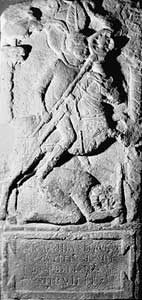
Click on the image for a larger version.
|
Image
details:
The tombstone of Flavinus, standard bearer
of the cavalry unit the ala Petriana. The depiction
of the cavalryman riding down a barbarian was a favoured tombstone
relief for Roman auxiliary cavalry troopers
Image ownership:
© Roger Tomlin |
The reference to six wounded soldiers in the strength report (154)
is perhaps the nearest the tablets let us to any fighting
between the Roman army and the Britons. Whether these wounded
men are the victims of a skirmish rather than a traffic accident
is not known. In fact the Britons are almost completely invisible
in the tablets, the most obvious exception being a memorandum on
their fighting capabilities. This might be an intelligence report,
an assessment of their suitability for recruitment, or perhaps advice
from a departing garrison commander to his successor (164).
'... the Britons are unprotected by armour (?). There are very
many cavalry. The cavalry do not use swords nor do the wretched
Britons mount in order to throw javelins.'
Such information was probably based on first-hand experience but
other news could be gathered by spies and scouts. 162
makes a possible reference to such a spy, an arcanus. A late
Roman author Ammianus Marcellinus refers to the activities of spies
in Britain, their duties being 'to circulate over a wide area and
report to our generals any threatening movements among the neighbouring
tribes'.
Although, disappointingly, the tablets lack direct reports of battles
or wars, they have allowed important deductions to be made about
the way the Roman army controlled conquered territory. Soldiers
did not remain in fixed strongpoints, venturing out only en masse
to engage the enemy, but were constantly on the move through the
landscape. The critical document is tablet 154,
which records the whereabouts of the members of one unit, the first
cohort of Tungrians, on 18th May of an unknown year. Of the 752
soldiers, the majority, 456, were not at Vindolanda. Most were at
Corbridge, perhaps for training, perhaps being gathered for a campaign.
46 soldiers were attending the governor as bodyguards. Smaller numbers
of other centurions and soldiers were posted at other unknown locations,
perhaps installations along the Stanegate. They might perhaps have
been deployed to administer the census, a task to which a very fragmentary
tablet refers (304).
Exceprt from Tablet 154
| Total
|
752 |
inc. 6
centurions |
| Absentees:
|
|
|
| Singulares
46 |
|
|
| Coria
|
337 |
inc. 2
centurions (?) |
| Londinium
|
1 |
centurion
(?) |
| ... |
6 |
inc.
1 centurion |
| ... |
9 |
inc. 1
centurion |
| ... |
11 |
|
| ... |
1 |
|
| ... |
45 |
|
| Total
|
456 |
inc.
5 centurions |
| Present:
|
|
|
| 296 |
|
inc. 1
centurion |
| Of whom
there are: |
|
|
| Unfit
31 |
|
|
| Healthy
|
265 |
inc. 1
centurion |
|
The number of soldiers, 752, is a little less than would be expected
for the largest type of infantry cohort (cohors
milliaria). The centurions number six rather than the expected
ten. Perhaps the unit was in the process of expansion from quingenary
to milliary, but perhaps being under-strength was the norm. The
officers are also distributed unevenly, only one centurion left
at Vindolanda with 296 men, and three others seemingly dispatched
with very small numbers of soldiers. This strength report may relate
to exceptional circumstances, but documents from other parts of
the empire also suggest that the subdivision of units was common.
Perhaps parts of other regiments were brigaded with the main Vindolanda
garrison. The presence of individuals from more than one unit is
often attested; for example when the ninth cohort of Batavians was
the main garrison individuals from the
third cohort also seem to be present. Often fort plans do not
fit the neat model for garrisoning units of standard type but also
suggest splitting and combining of different units.
A constant and reliable feed of information was necessary to allow
local commanders this flexibility in organising their forces. Optiones,
junior officers, regularly submitted a report of standard type that
all 'were present and correct', a document type (127)
first known from Vindolanda. 154
illustrates the strength reports that might be compiled concerning
units as a whole. There are similar documents known from other parts
of the empire, some rather more formal summaries submitted on the
last day of the month or year. Units are likely to have transmitted
such reports to the governor, commander-in-chief of the army of
each province. Co-ordination with units beyond Vindolanda also depended
on the availability of information. Plenty of documents attest to
Vindolanda's links with other garrisons, especially letters between
prefects, as well as with a regional authority, the centurio
regionarius at Carlisle (250).
Even if there are no letters directly to or from the governor, the
references to him in other correspondence imply the maintenance
of close relations (225,
248).
The tablets' very existence is perhaps the most significant information
that Vindolanda adds to our understanding of Roman military operations.
The maintenance of close communication through documents gave much
more flexibility in meeting an enemy numerically superior but lacking
the information advantage.
|